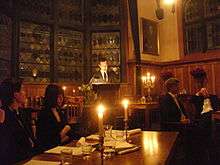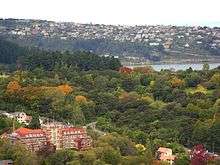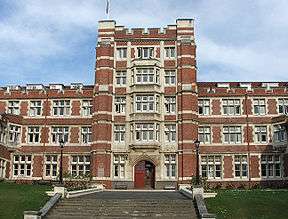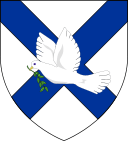Knox College, Otago
| Knox College | ||||||||||||
|---|---|---|---|---|---|---|---|---|---|---|---|---|
| University of Otago Residential College | ||||||||||||
|
Knox facade | ||||||||||||
|
Knox College Coat of Arms | ||||||||||||
|
| ||||||||||||
| University | University of Otago | |||||||||||
| Location | 9 Arden St, North East Valley, Dunedin | |||||||||||
| Motto | Gratia et Veritas | |||||||||||
| Motto in English | Grace and Truth | |||||||||||
| Founders | Rev Andrew Cameron and John Ross[1] | |||||||||||
| Established | 1909 | |||||||||||
| Status | Affiliated | |||||||||||
| Master | The Very Reverend Dr. Graham Redding (from January 2015) | |||||||||||
| KCSC president | Daniel Guthrie | |||||||||||
| Undergraduates | 262 | |||||||||||
| Website | knoxcollege.ac.nz | |||||||||||
Knox College is a Presbyterian residential college affiliated to the University of Otago in New Zealand, providing accommodation for primarily first and second year students, with one third year student. The college is set in an 4.57 hectares (11.3 acres) landscaped site in Opoho on the opposite side of the Dunedin Botanic Gardens from the University. The site is shared with Salmond College, which was originally set up as complementary accommodation for female students. Although the institutions are run autonomously, they were until recently governed by a joint body, The Council of Knox College and Salmond College.
Function
Knox College was established in 1909 to provide residential accommodation for male students and to house an existing seminary for Presbyterian ministers. It became co-educational in 1983 and also houses the Knox Centre for Ministry and Leadership and the Archives Research Centre, under the Presbyterian Church of Aotearoa New Zealand. The principal buildings were designed by W. Gray Young when he was only 21.[2]
Knox seeks to recreate some of the feeling of an Oxford or Cambridge college and much of its institutional terminology originated in these universities: recalcitrant students are "sent down"; there is a "Master" and there are "Fellows". However, roles may be distributed in a different manner to the British model; responsibility for security outside of office-hours lies with the Assistant Master and Sub-Masters rather than, say, College Porters. Knox also retains many traditional aspects of college life, such as requiring jackets and ties for most dinners and making division into Senior and Junior Common Rooms. Senior Common Room members are, in addition, expected to wear academic (undress) gowns for Sunday evening meals.[3]

In keeping with this ethos and with its ecclesiastic roots, sung Evensong is held in the College's Ross Chapel each week during term-time, led by the resident College Choir. The College's history describes the music as being "in the Royal School of Church Music tradition" and, indeed, Knox College acts as the regional Registered Office of the RSCM, New Zealand for Otago & Southland.[1][4]
Many students will undertake some formal, college-coordinated learning at some stage during their residence, though the responsibility for students' education is ultimately borne by the university rather than the college, with students registering for or altering courses directly through the university administration. The College takes an active role in monitoring students' academic progress, requiring the majority of students to attend progress interviews. In addition, the college benefits from an on-campus library, the Hewitson Library, which provides continuous access for students to study space, a small cluster of computers and its primarily theological collection.[5]
The Senior Common Room largely consists of (non-resident) academics and leading figures of the community elected into fellowship on a quinquennial basis. A number of Fellows in Residence, usually in the initial stages of an academic career (at masters, doctoral and postdoctoral level) are also included in the SCR. The stipendiary Ross Fellowship, established in 1920 and still held by a Resident Fellow of the College, is amongst the oldest such awards in the University. Until recently, certain Chairs in theology were held at Knox College.[6][7]
The visitor is the Moderator of the Presbyterian Church of Aotearoa New Zealand.[8]
Students' club and events
The Knox College Students' Club (KCSC) is an incorporated society and one of the oldest college organisations of its kind in New Zealand, having drawn up its constitution in 1909. The majority of student social events and intercollegiate events are organised through the KCSC Executive Committee, or student nominated Club members, and form a broad range of activities throughout the year. Particularly notable amongst these annual events are the two College Balls (in Autumn and Winter) and the Annual Blue Tyre Race, a time trial competition, run since 1963, (originally racing motor vehicles uphill, now motor-less contraptions downhill).[1]
Former presidents of the Students' Club include Professor Sir David Skegg, the former Vice-Chancellor of the university, and a former Master of the college, Bruce Aitken.
The College organises a number of events, sometimes in co-ordination with the Students' Club, including College Feasts, musical and speaker events, a debating contest between the Junior and Senior Common Rooms and various liturgically-themed Chapel services.
Centennial celebrations
The College achieved its centenary in 2009, with approximately 600 guests attending a variety of events over the celebration weekend in early August. The oldest returning resident (res. 1938–1943) planted a Centennial Oak in the College grounds to commemorate the occasion.[9][10]
A large congratulatory note was spray-painted onto the grass in front of the College during the weekend, reading 'Happy 100th Birthday', provenance unknown.
Relationships to other colleges
Knox College's Anglican equivalent is its arch-rival Selwyn College with which it contests the Nevill Cup and Cameron Shield each year.
Building history
The college buildings are an imposing group representing a persistent and successful effort to carry out an architectural idea over an extended time which saw considerable change.
Initial outlay
The Presbyterian Church of Otago and Southland opened a seminary for Ministers, its Theological Hall, in Dunedin in 1876. Early in the 20th century it acquired the core of the site in Opoho, above North East Valley, intending to re-house the seminary and to provide accommodation for its students and others attending the University of Otago. It established a brief and conducted an architectural competition won by William Gray Young (1885–1962) of Wellington in 1906.(W. Gray Young) J.Louis Salmond (1868–1950) came second.[11][12]

Young's plans envisaged development well beyond the college's immediate requirements taking the form of four ranges surrounding a central quadrangle. After the first stage was completed he was retained as architectural adviser and remained responsible for the buildings’ design for more than forty years. His successors remained true to his conception through challenging circumstances.
Because Young was based in Wellington and perhaps also because of his youth, Salmond was appointed supervising architect. The plan called for a principal range facing west with a large, square, central tower. It had subordinate ranges reaching forward at either extremity in a generally symmetrical composition. Behind the west range there were to be others at right angles to it, extending east, forming the north and south sides of the quadrangle.
The first building stage was the tower and the northward parts of the west range together with the range behind that trending east on the north side of the intended quadrangle (the “North Wing”). This part, the range on the north side of the quadrangle, included not only provision for teaching but a dining hall and servants’ accommodation.
The foundation stone was laid on 6 April 1908 and the building was opened on 23 June 1909 having cost £19,307. The foundations were Port Chalmers breccia. The walls were finished in brick with Oamaru stone trims and the roofs were red clay tiles.
The building was in the Jacobethan style, a late form of the Gothic revival still vigorous in the early 20th century. Knox has the characteristic Tudor arches, oriel windows and battlements and the elaboration of forms and details, if not to the extent of Harlaxton Manor, sometimes pointed to as the type, or template, of the style.[13]
Early development
The second stage was the southern part of the west range, including the forward projecting chapel. Behind this part of the west range the first part of the quadrangle’s southern range was also to be built. A tender was accepted in September 1912 and completed by March 1914. Construction had cost £10,525.
At this point the College Council’s ambitions and those of their architect were becoming clear. On their high site the buildings are very visible. The council had insisted on raising the architect’s four-storeyed tower to five storeys. The three storeyed ranges and the forward thrusting subordinate reaches present a complex, but legible and imposing face to the world.
The interiors were spacious and finished with period detailing, including panels and hammer beams in the Dining Hall and stained glass and elaborate plasterwork, notably in the Chapel. Even so, the college, as Young had conceived it, was far from complete.
Plans to extend the southern range, known as the “South Wing”, were prepared by him in enough detail to be estimated by 1929 but the Depression and the Second World War prevented their execution. In 1952 with plans and funding almost complete the project was suspended.
Post-war progress
Meanwhile, the combination of seminary and residential hall was proving difficult to accommodate in the existing space. In 1945 a fund was established to provide additional room. Young was getting old. He oversaw the drafting of the plans but advised the committee of his resignation in 1952. Salmond had died in 1950. His son, Arthur Salmond, (1906–1994) now in partnership with Harry Burt, took over the project.[14] A contract was signed in 1953, building commenced the next year and the new Theological Hall was opened on 12 November 1955 for a cost of £80,000.
The new building, to become known as the Hewitson Wing, was set parallel to the main west range, behind it, forming the east flank of the quadrangle. With a library as its front, facing the quadrangle, and with a hall behind, this structure is very deep. It is linked by an arch to the north range, closing the quadrangle's corner at that point.
Building methods and codes had changed. This structure, the first of the second building phase, incorporated reinforced concrete while retaining the forms and materials of the earlier buildings. It too is decorated inside in period fashion, the library, for example, managing to make the reference to an Elizabethan interior with a plausible degree of conviction.
The former provision for the Theological Hall in the north range was now made into additional accommodation for residents. This meant the Dining Hall was now too small for the numbers. That had been anticipated in the Gray Young era but in 1953 the council commissioned Salmond & Burt to prepare plans to extend the hall, estimated at £2,500. The work was completed by July 1957.
The extension reaches into the quadrangle courtyard, terminating in a crenellated bay window with stained lead lights. Inside it provides the space for the dais for the hall's high table and seems a natural enlargement of the room.
In 1959 the College Council resumed its effort to extend the "South Wing". Money was raised, the plans revised, tenders were called in August 1961. The building was opened on 21 April 1963 for a cost of £44,501. This was another structure with a reinforced concrete frame, styled and dressed to match the building it joined. It extended the "South Wing" eastward, taking the southern range to its present extent, further closing the quadrangle. It stopped short of the line of the east range which at that time had not reached its full extent. It was named the "Ross Wing".
The quadrangle was still not completed and with the centennial of the Theological Hall approaching the College Council decided in August 1974 to mark it by extending the library. Fund raising was difficult but work began in August 1983. The extension was opened on 30 May 1984 for a cost of $463,000.
This is another structurally modern building dressed to complement the context. By this time Arthur Salmond had retired but his son John (1940–2008) was in practice.[16] The addition extends the east range southwards, taking it to the line of the south range but leaving an open space between. With this the quadrangle was all but complete.
Post-millennial contributions
By 2003 the College Council had formed plans to close the gap and thus complete the courtyard; to re-form the entry to the tower from the quadrangle; and to provide space for archives in an addition to the Theological Hall, or a new building beside it. The brochure announcing the centennial celebrations to be held in August 2009 referred to the extension of the Ross Wing and another extension of the "Great Hall" as projects to be launched before the celebrations. In the summer of 2012/2013 the College was strengthened to comply with the building code and the Great Hall was opened up to the Junior Common Room to facilitate dining for the increased numbers at the college on formal occasions [17]
Summary
The buildings are a striking essay in their manner. They conjure a real sense of the grand home of a cloistered religious and academic community of the past. They also meet the needs of a contemporary New Zealand university hall of residence. Their significance is the material evidence they provide of the possibility of successfully persevering with ambitious architectural ideas through challenging times.
The building housing Knox College, University of Toronto makes an interesting comparison. It takes a similar form around a quadrangle, has a comparable tower and was designed in a similar style. But it was completed in 1914, not slowly over decades.
Appointment of Governance Commission
In February 2012, a Commission was appointed by the General Assembly of the Presbyterian Church of Aotearoa New Zealand to oversee the governance and management of Knox and Salmond Colleges, instead of the Council.[18] The General Assembly took this action because of concerns over alcohol abuse and out of concern for the safety and welfare of students living in Knox College.[19] As a result of the investigation, the former master of the College, Bruce Aitken, offered his resignation on 20 July 2012.[20] However, some of the changes proposed by the Commission, including things such as the removal of regular formal dining and the unnecessary name change of various College facilities, generated significant controversy. Some alumni felt that these changes were essentially cultural in nature, and went far beyond advancing safety and welfare. They also objected to the lack of consultation. This led hundreds of alumni from around the world to sign petitions and write in protest, attracting national press attention.[21] Despite this, some traditional elements of college life such as orientation week, formal balls, formal dining, and sporting and cultural events remain a part of Knox culture.[22]
Notable alumni
|
While many of those above have been resident at the College, some of those who attended as Divinity students may have received tuition while living in private accommodation.
The College has provided 17 Rhodes Scholars (including any listed above) and several Gates Scholars and Fulbright Scholars. For further details of these and certain other of the alumni above, see the College's centennial history. Years provided are of initial entry, rather than of any returning periods.[1][34]
Notes
- 1 2 3 4 Clarke, Alison (2009), A Living Tradition: A Centennial History of Knox College, Knox College
- ↑ "William Gray Young". Dictionary of New Zealand Biography. Retrieved 25 June 2010.
- ↑ for instance, visiting fellow and Iroquois scholar, William N. Fenton, refers to dining in 1975 'with the Master and faculty at the high table, as in British university colleges'. Fenton, Campisi & Starna, 1975, p. 160
- ↑ Royal School of Church Music, New Zealand – official website
- ↑ Knox College. "Knox College Blue Book" (PDF).
- ↑ Knox College. "College Scholarships".
- ↑ For example: Cheyne, A C (1999), Studies in Scottish church history, p. 273; Numbers; Stenhouse (2001), Disseminating Darwinism, the Role of Place, Race, Religion, and Gender, p. 70
- ↑ Knox College. "Who's who". Retrieved 25 June 2010.
- ↑ "Fellows celebrate 100 years of Knox". Otago Daily Times. 10 August 2009.
- ↑ Knoxonian (college magazine), 2009
- ↑ Breward, Ian (1975), Grace and Truth: a History of Theological Hall, Knox College, Dunedin, 1876–1975, p. 9
- ↑ Except where otherwise stated information here about the buildings’ history is drawn from Salmond 2003. That in turn relies substantially on Milnes 2002.
- ↑ Curl, 2000. "Jacobethan."; Encyclopedia.com. 25 Apr 2009 <http://www.encyclopedia.com>.
- ↑ Otago Daily Times, 5 February 1994. Obituary Arthur Louis Salmond.
- ↑ This image shows the Ross and South Wings on the right, as well the more recent Somerville Court, along Glendining Avenue, to the left
- ↑ Otago Daily Times, 16 August 1980 states AL Salmond had retired two years earlier. 1 November 2008, obituary John Louis Salmond, mentions JL Salmond's work for Knox College. Knight & Wales, 1988, pp.216–217 gives information about the individuals and the practice.
- ↑ http://www.knoxcollege.ac.nz/?p=1944 Missing or empty
|title=(help) - ↑ Presbyterian news
- ↑ Knox College Commission letter
- ↑ http://www.knoxcollege.ac.nz/?p=1658
- ↑ http://www.odt.co.nz/campus/university-otago/198083/knox-students-petition-faculties-over-changes
- ↑ http://www.knoxcollege.ac.nz/wp-content/uploads/2012/02/Revised-Handbook-20123.pdf
- ↑ http://www.independent.co.uk/news/people/obituary-sir-robert-aitken-1267474.html
- ↑ http://www.schweizerbart.de/publications/detail/artno/058009500
- ↑ http://www.lichenology.org/Awards/Acharius_Galloway.html
- ↑ http://hannahinzambia.wordpress.html
- ↑ http://www.otago.ac.nz/genetics/staff/petersen.html
- ↑ http://www.dnzb.govt.nz/dnzb/default.asp?Find_Quick.asp?PersonEssay=5B12
- ↑ http://www.independent.co.uk/news/obituaries/professor-ian-mcdonald-429219.html
- ↑ http://www.dnzb.govt.nz/dnzb/default.asp?Find_Quick.asp?PersonEssay=5R15
- ↑ Sir George Douglas Robb (1967), Medical odyssey, Collins
- ↑ http://www.dnzb.govt.nz/dnzb/default.asp?Find_Quick.asp?PersonEssay=4M25
- ↑ http://www.dnzb.govt.nz/dnzb/default.asp?Find_Quick.asp?PersonEssay=5N12
- ↑ Knox College. "Knox Centennial Celebration – Newsletter #4".
References
- Breward, Ian, Grace and Truth: a History of Theological Hall, Knox College, Dunedin, 1876–1975, Dunedin : Theological Education Committee, Presbyterian Church of New Zealand, 1975.
- Cheyne, A. C., Studies in Scottish church history, 1999
- Fenton, Campisi & Starna, Iroquois journey: an anthropologist remembers, 2007
- Clarke, Alison, A Living Tradition: A Centennial History of Knox College, 2009
- Curl, James Stevens, A Dictionary of Architecture and Landscape Architecture, Oxford University Press, 2000. ISBN 0-19-860678-8.
- Knight, Hardwicke & Wales, Niel, Buildings of Dunedin, John McIndoe Limited, Dunedin, 1988.
- Milnes, John, History of the Knox College Site and Buildings 1902–2002.
- Numbers & Stenhouse, Disseminating Darwinism, the Role of Place, Race, Religion, and Gender, 2001
- Otago Daily Times, Dunedin, 1861–.
- Salmond, AJ, Knox College Conservation Plan 2004, Salmond Anderson Ltd, Dunedin, 2003.
External links
| Wikimedia Commons has media related to Knox College, Otago. |
- Official website
- Knox College Blue Book; College-maintained "reference guide to life at Knox"
- School of Ministry, Knox College
Coordinates: 45°51′20″S 170°31′27″E / 45.855527°S 170.524238°E

